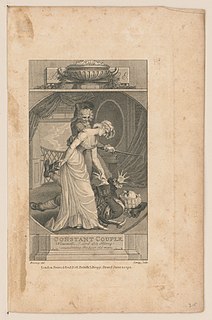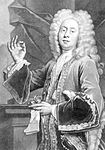Related Research Articles

George Farquhar was an Irish dramatist. He is noted for his contributions to late Restoration comedy, particularly for his plays The Constant Couple (1699), The Recruiting Officer (1706) and The Beaux' Stratagem (1707).
This article contains information about the literary events and publications of 1701.
Susanna Verbruggen, aka Susanna Mountfort, was an English actress working in London.
Benjamin Johnson was an English actor.

Robert Wilks was a British actor and theatrical manager who was one of the leading managers of Theatre Royal, Drury Lane in its heyday of the 1710s. He was, with Colley Cibber and Thomas Doggett, one of the "triumvirate" of actor-managers that was denounced by Alexander Pope and caricatured by William Hogarth as leaders of the decline in theatrical standards and degradation of the stage's literary tradition.

John Bell (1745–1831) was an English publisher. Originally a bookseller and printer, he also innovated in typography, being responsible for an influential font that omitted the long s. He was also noted for drawing the reading public to "the best literature" by commissioning attractive art work to accompany the printed work.

The 1922 Dissolution Honours List was issued on 19 October 1922 at the advice of the outgoing Prime Minister, David Lloyd George.
Events from the year 1704 in Ireland.

James William Dodd (1740?–1796) was an English actor, one of David Garrick's picked company.

William Pinkethman(also Penkethman, Pinkeman, Pinkerman, etc.; nicknamed Pinkey) (c.1660–1725) was an English comic actor, a low comedian with a droll style, and theatre manager. He was considered an imitator of Anthony Leigh.

Mrs Goodall or Charlotte Goodall or Charlotte Stanton was a British actress known for her comedy roles at Drury Lane. She married Thomas Goodall and they were involved in a noted legal case.
Sir Harry (1924-1930) was an American Thoroughbred racehorse owned by the Seagram family stables who won the 1927 Coffroth Handicap, the then richest race in North America with a purse of $100,000. Race conditioned by future Hall of Fame trainer William Bringloe and ridden by the highly regarded young jockey Ovila Bourassa, that same year Sir Harry ran second in the 1927 Preakness Stakes, the second leg of the U.S. Triple Crown series.

The Constant Couple is a 1699 play by the Irish writer George Farquhar. It is part of the Restoration comedy tradition, and is often described as a sentimental comedy. It marked the first major success of Farquhar's career. A series of comic misunderstandings are triggered when three rivals vie for the hand of the wealthy heiress Lady Lurewell.
The Fair Example, or the Modish Citizen is a 1703 comedy play by the English writer Richard Estcourt, originally staged at the Drury Lane Theatre. It was part of a growing trend of plays to feature a plot of an honest wife reforming her rakish husband along with Sir Harry Wildair, As You Find It, The Wife's Relief and The Modish Couple. It is a reworking of the 1693 French play Les Bourgeoises à la Mode by Florent Carton Dancourt. In 1705 a separate English adaptation of the French work John Vanbrugh's The Confederacy appeared at the rival Queen's Theatre in the Haymarket.
John Mills (c.1670–1736) was a British stage actor. A long-standing part of the Drury Lane company from 1695 until his death, he appeared in both comedies and tragedies. His wife Margaret Mills was an actress, and his son William Mills also became an actor at Drury Lane.
Hibernia Freed is a 1722 tragedy by the writer William Phillips. It is set during the ninth century during the Viking Invasion of Ireland. It was part of a growing Anglo-Irish interest in traditional Irish history, and part of a tendency to switch tragedy from Ancient Rome or Greece to more native settings.
Henry Giffard (1694–1772) was a British stage actor and theatre manager.
Thomas Simpson was an English stage actor of the late seventeenth and early eighteenth century. His surname is sometimes written as Sympson.
George Pack was a British stage actor, singer and theatre manager of the eighteenth century. His first known performance on the London stage was as Westmoreland in Shakespeare's Henry IV at the Lincoln's Inn Fields Theatre and he remained with the company until it transferred to the Queens's Theatre in the Haymarket in 1705. He played in a mixture of comedies and tragedies, originating roles in plays by many of the leading dramatists of the era including Nicholas Rowe, Mary Pix, John Vanbrugh and Susanna Centlivre.
Jane Lucas was an English stage actress and singer of the late seventeenth and early eighteenth century. From around 1693 she was a member of the United Company based at the Theatre Royal, Drury Lane. In 1697 she had fellow actor Colley Cibber arrested, although the reason was not clear and she remained acting in the company alongside him for some years afterwards.
